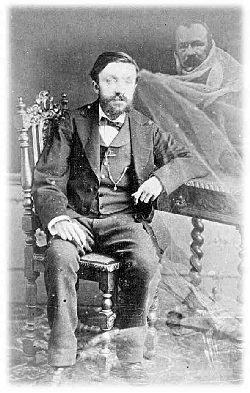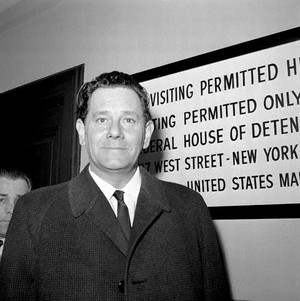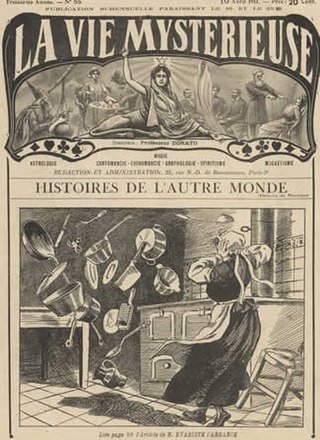
Clairvoyance is the claimed psychic ability to gain information about an object, person, location, or physical event through extrasensory perception. Any person who is claimed to have such ability is said to be a clairvoyant.
Extrasensory perception (ESP) also known as the sixth sense, is a paranormal ability about receiving information not gained through the recognized physical senses, but sensed with the mind. It is claimed to be more sophisticated than intuition and the knowledge obtained is usually received from dreams, astral projection, or psychic abilities.

Parapsychology is the study of alleged psychic phenomena and other paranormal claims, for example, those related to near-death experiences, synchronicity, apparitional experiences, etc. Criticized as being a pseudoscience, the majority of mainstream scientists reject it. Parapsychology has also been criticised by mainstream critics for claims by many of its practitioners that their studies are plausible despite a lack of convincing evidence after more than a century of research for the existence of any psychic phenomena.

Telepathy is the purported vicarious transmission of information from one person's mind to another's without using any known human sensory channels or physical interaction. The term was first coined in 1882 by the classical scholar Frederic W. H. Myers, a founder of the Society for Psychical Research (SPR), and has remained more popular than the earlier expression thought-transference.

A ganzfeld experiment is an assessment used by parapsychologists that they contend can test for extrasensory perception (ESP) or telepathy. In these experiments, a "sender" attempts to mentally transmit an image to a "receiver" who is in a state of sensory deprivation. The receiver is normally asked to choose between a limited number of options for what the transmission was supposed to be and parapsychologists who propose that such telepathy is possible argue that rates of success above the expectation from randomness are evidence for ESP. Consistent, independent replication of ganzfeld experiments has not been achieved, and, in spite of strenuous arguments by parapsychologists to the contrary, there is no validated evidence accepted by the wider scientific community for the existence of any parapsychological phenomena. Ongoing parapsychology research using ganzfeld experiments has been criticized by independent reviewers as having the hallmarks of pseudoscience.

Alfred Rupert Sheldrake is an English author and parapsychology researcher. He proposed the concept of morphic resonance, a conjecture that lacks mainstream acceptance and has been widely criticized as pseudoscience. He has worked as a biochemist at Cambridge University, a Harvard scholar, a researcher at the Royal Society, and a plant physiologist for ICRISAT in India.
Remote viewing (RV) is the practice of seeking impressions about a distant or unseen subject, purportedly sensing with the mind. Typically a remote viewer is expected to give information about an object, event, person or location that is hidden from physical view and separated at some distance. Physicists Russell Targ and Harold Puthoff, parapsychology researchers at Stanford Research Institute (SRI), are generally credited with coining the term "remote viewing" to distinguish it from the closely related concept of clairvoyance. According to Targ, the term was first suggested by Ingo Swann in December 1971 during an experiment at the American Society for Psychical Research in New York City.
Paranormal events are purported phenomena described in popular culture, folk, and other non-scientific bodies of knowledge, whose existence within these contexts is described as being beyond the scope of normal scientific understanding. Notable paranormal beliefs include those that pertain to extrasensory perception, spiritualism and the pseudosciences of ghost hunting, cryptozoology, and ufology.
The Stargate Project was a secret U.S. Army unit established in 1978 at Fort Meade, Maryland, by the Defense Intelligence Agency (DIA) and SRI International to investigate the potential for psychic phenomena in military and domestic intelligence applications. The project, and its precursors and sister projects, originally went by various code names – 'Gondola Wish', 'Stargate', 'Grill Flame', 'Center Lane', 'Project CF', 'Sun Streak', 'Scanate' – until 1991 when they were consolidated and rechristened as the "Stargate Project".

Zener cards are cards used to conduct experiments for extrasensory perception (ESP). Perceptual psychologist Karl Zener (1903–1964) designed the cards in the early 1930s for experiments conducted with his colleague, parapsychologist J. B. Rhine (1895–1980).
Dean Radin investigates phenomena in parapsychology. Following a bachelor and master's degree in electrical engineering and a PhD in educational psychology Radin worked at Bell Labs, as a researcher at Princeton University and the University of Edinburgh, and was a faculty member at University of Nevada, Las Vegas. He then became Chief Scientist at the Institute of Noetic Sciences (IONS) in Petaluma, California, USA, later becoming the president of the Parapsychological Association. He is also co-editor-in-chief of the journal Explore: The Journal of Science and Healing. Radin's ideas and work have been criticized by scientists and philosophers skeptical of paranormal claims. The review of Radin's first book, The Conscious Universe, that appeared in Nature charged that Radin ignored the known hoaxes in the field, made statistical errors and ignored plausible non-paranormal explanations for parapsychological data.

Marcello Truzzi was a professor of sociology at New College of Florida and later at Eastern Michigan University, founding co-chairman of the Committee for the Scientific Investigation of Claims of the Paranormal (CSICOP), a founder of the Society for Scientific Exploration, and director for the Center for Scientific Anomalies Research.

Robert Todd Carroll was an American author, philosopher and academic, best known for The Skeptic's Dictionary. He described himself as a naturalist, an atheist, a materialist, a metaphysical libertarian, and a positivist. In 2010 he was elected a fellow of the Committee for Skeptical Inquiry. He was a professor of philosophy at Sacramento City College from 1977 until his retirement in 2007.

Pieter van der Hurk known as Peter Hurkos, was a Dutchman who claimed he manifested extrasensory perception (ESP) after recovering from a head injury and coma caused by a fall from a ladder when aged 30. He came to the United States in 1956 for psychic experiments, later becoming a professional psychic who sought clues in the Manson Family murders and the Boston Strangler case. With the help of businessman Henry Belk and parapsychologist Andrija Puharich, Hurkos became a popular entertainer known for performing psychic feats before live and television audiences.

Staring is a prolonged gaze or fixed look. In staring, one subject or person is the continual focus of visual interest, for an amount of time. Staring can be interpreted as being either hostile like disapproval of another's behavior, or the result of intense concentration, interest or affection. Staring behavior can be considered as a form of aggression like when it is an invasion of an individual's privacy in certain contexts, or as a nonverbal cue to convey feelings of attraction in a social setting. The resultant behavior or action defines whether it is aggressive in nature, passive or active expression of attraction, etc. However, to some extent staring often occurs accidentally, and often a person would be simply staring into a space for awareness, or could be lost in thought, stupefied, or be unable to see. As such, the meaning of a person's staring behavior depends upon the attributions made by the observer.

A psychic reading is a specific attempt to discern information through the use of heightened perceptive abilities; or natural extensions of the basic human senses of sight, sound, touch, taste and instinct. These natural extensions are claimed to be clairvoyance (vision), clairsentience (feeling), claircognisance and clairaudience (hearing) and the resulting statements made during such an attempt. The term is commonly associated with paranormal-based consultation given for a fee in such settings as over the phone, in a home, or at psychic fairs. Though psychic readings are controversial and a focus of skeptical inquiry, a popular interest in them persists. Extensive experimentation to replicate psychic results in laboratory conditions have failed to find any precognitive phenomena in humans. A cold reading technique allows psychics to produce seemingly specific information about an individual from social cues and broad statements.
Sensory leakage is a term used to refer to information that transferred to a person by conventional means during an experiment into ESP.

The Men Who Stare at Goats (2004) is a non-fiction book by Jon Ronson concerning the U.S. Army's exploration of New Age concepts and the potential military applications of the paranormal. The title refers to attempts to kill goats by staring at them and stopping their hearts. The book is a companion to a three-part TV series broadcast in Britain on Channel 4—Crazy Rulers of the World (2004)—the first episode of which is also entitled "The Men Who Stare at Goats". The same title was used a third time for a loose feature film adaptation in 2009.

Telekinesis is a hypothetical psychic ability allowing an individual to influence a physical system without physical interaction. Experiments to prove the existence of telekinesis have historically been criticized for lack of proper controls and repeatability. There is no reliable evidence that telekinesis is a real phenomenon, and the topic is generally regarded as pseudoscience.

Looking is the act of intentionally focusing visual perception on someone or something, for the purpose of obtaining information, and possibly to convey interest or another sentiment. A large number of troponyms exist to describe variations of looking at things, with prominent examples including the verbs "stare, gaze, gape, gawp, gawk, goggle, glare, glimpse, glance, peek, peep, peer, squint, leer, gloat, and ogle". Additional terms with nuanced meanings include viewing, watching, eyeing, observing, beholding, and scanning. Looking is both a physical act of directing the focus of the eyes, and a psychological act of interpreting what is seen and choosing whether to continue looking at it, or to look elsewhere. Where more than one person is involved, looking may lead to eye contact between those doing the looking, which raises further implications for the relationship established through that act.













